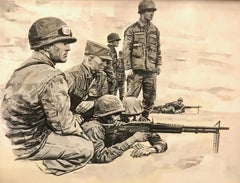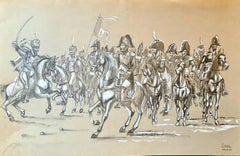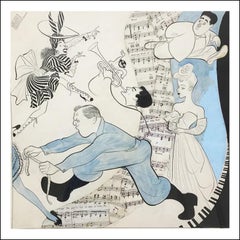Charles Ellis Drawings and Watercolor Paintings
to
2
1
Overall Width
to
Overall Height
to
3
1
2
1
3
3
2
1
1
1
1
1
3
2
1
1
1
19
932
406
282
279
1
3
Artist: Charles Ellis
Military Illustration
By Charles Ellis
Located in Fort Washington, PA
Medium: Ink on Board
Signature: Signed Lower Left
Contact for dimensions.
Category
20th Century Charles Ellis Drawings and Watercolor Paintings
Materials
Ink, Board
Victorian Memories
By Charles Ellis
Located in Fort Washington, PA
Medium: Watercolor on Board
Dimensions: 18.00" x 12.00"
Signature: Unsigned
Category
Late 20th Century Charles Ellis Drawings and Watercolor Paintings
Materials
Watercolor, Board
A Year in Review: 1969
By Charles Ellis
Located in Fort Washington, PA
Date: 1969
Medium: Pen and Ink on Board
Dimensions: 24.00" x 16.00"
Signature: Unsigned
Category
1960s Charles Ellis Drawings and Watercolor Paintings
Materials
Ink, Board, Pen
Related Items
Napoleon at the Head of His Grande Armée, His Generals and the Prussian Hussars
Located in Cotignac, FR
Pencil, chalk and watercolour depiction of Napoleon at the head of his generals by French artist Jean Ducel. The work is signed bottom right.
A bold and graphic depiction of Napoleo...
Category
Late 20th Century Outsider Art Charles Ellis Drawings and Watercolor Paintings
Materials
Chalk, Crayon, Cardboard, Pencil, Watercolor
Al Hirschfeld "Beat the Band" New York Times Broadway Theatre Illustration 1940s
By Albert Al Hirschfeld
Located in New York, NY
Al Hirschfeld (1903-2003)
"Beat the Band"
22 x 26 1/2 inches
ink on board
published in The New York Times, October 11, 1942
The unframed work comes directly from the Al Hirschfeld F...
Category
1940s American Realist Charles Ellis Drawings and Watercolor Paintings
Materials
Ink, Board
Original Painting. Colliers Magazine Cover Published 1933 Wedding Illustration
By Antonio Petruccelli
Located in New York, NY
Original Painting. Colliers Magazine Cover Published 1933 Wedding Illustration
Antonio Petruccelli (1907 - 1994)
The Wedding
Colliers published, June 17, 1933
17 1/4 X 11 1/2 inches (sight)
Framed 23 1/4 X 17 1/2 inches
Gouache on board
Signed lower right
BIOGRAPHY:
Antonio Petruccelli (1907-1994) began his career as a textile designer. He became a freelance illustrator in 1932 after winning several House Beautiful cover illustration contests.
In addition to 24 Fortune magazine covers, four New Yorker covers, several for House Beautiful, Collier’s, and other magazines he did numerous illustrations for Life magazine from the 1930s – 60s.
‘Tony was Mr. Versatility for Fortune. He could do anything, from charts and diagrams to maps, illustrations, covers, and caricatures,’ said Francis Brennan, the former art director for Fortune.
Over the course of his career, Antonio won several important design awards, designing a U.S. Postage Stamp Commemorating the Steel Industry and designing the Bicentennial Medal...
Category
1930s American Realist Charles Ellis Drawings and Watercolor Paintings
Materials
Gouache, Board
"Judy Garland" Legendary Film and Recording Star. Gay Icon. 20th Century Litho
By Albert Al Hirschfeld
Located in New York, NY
"Judy Garland" Legendary Film and Recording Star. Gay Icon. 20th Century Litho
Al Hirschfeld (1903 - 2003)
Judy Garland
20 x 15 inches (sight)
Etching
26 1/2 x 14 3/4 inches Framed...
Category
1970s Performance Charles Ellis Drawings and Watercolor Paintings
Materials
Ink, Board
Head of Medusa
Located in Indianapolis, IN
Titled and signed lower center and right.
Category
20th Century Charles Ellis Drawings and Watercolor Paintings
Materials
Clay, India Ink, Board
Original Painting. New Yorker Mag Cover Proposal WPA Mid Century American Scene
By Antonio Petruccelli
Located in New York, NY
Original Painting. New Yorker Mag Cover Proposal WPA Mid Century American Scene
Antonio Petruccelli (1907 – 1994)
Perplexed Gentleman
New Yorker cover proposal, c. 1939
13 1/4 X 8 ...
Category
1930s American Modern Charles Ellis Drawings and Watercolor Paintings
Materials
Gouache, Board
Church Interior
By Ray Quigley
Located in Buffalo, NY
A modern illustration by American artist Ray Quigley depicting two men inside of a church.
Category
1950s Realist Charles Ellis Drawings and Watercolor Paintings
Materials
Gouache, Illustration Board, Ink
Original Judy Garland Get Happy Drawing. Legendary Star. Caricature. Not a Litho
By Albert Al Hirschfeld
Located in New York, NY
Original Judy Garland Get Happy Drawing. Legendary Star. Caricature. Not a Litho.
Al Hirshfeld (1903-2003)
Judy "All Star Variety" Garland at the Palace
Ink on board, 1955
Sight: 16...
Category
1950s Performance Charles Ellis Drawings and Watercolor Paintings
Materials
Ink, Board
Original TV Guide Illustration Caricature Esther Williams John Raitt Dinah Shore
By Albert Al Hirschfeld
Located in New York, NY
Original TV Guide Illustration Caricature Esther Williams John Raitt Dinah Shore. Published December 25, 1957 in TV Guide as an editorial to promote the Di...
Category
1950s Performance Charles Ellis Drawings and Watercolor Paintings
Materials
Ink, Board
$12,000
H 15 in W 22 in D 2 in
Mother and Child - Drawing - 1962
Located in Roma, IT
Mother and Child is an artwork realized by an unknown artist in 1962.
Black Marker Pen on Cardboard
27.5 x 22.5 cm ; 60 55 cm with frame.
Unreadable signature in the lower part.
...
Category
1960s Contemporary Charles Ellis Drawings and Watercolor Paintings
Materials
Board, Pen
I Am A Dog
By Olivia Gibb
Located in Kansas City, MO
Title : I Am A Dog
Materials : paste,ink,pencil,pen
Date : 2016
Dimensions : 8.5×11
Signed
COA provided
Art school took Olivia Gibb away from Oklahoma and up to Kansas City, which s...
Category
2010s Contemporary Charles Ellis Drawings and Watercolor Paintings
Materials
Paste, Ink, Pen, Pencil
View of Dunoon on the Clyde
Located in Hillsborough, NC
Scottish artist Robert Carrick (1829-1904) is renowned for his landscape and figurative paintings in oil and watercolor. This painting features detailed drawings of figures in the foreground with wagon, and the town and scenery in the background, painted over in watercolor in rich raw umber and red-brown tones in the foreground and blue green tones in the background.
Carrick showed promise at a young age, exhibiting his work at the Royal Academy age 16. He was a member of the Royal Institute. This two-toned watercolor work has detailed figures, wagon with hay in the forefront above a view of Dunoon town near Glasgow as it was long ago. Signed by the artist, lower left with an inscription that reads: 'View of Dunoon, Argyllshire drawn by Robert Carrick, Glasgow, for David Allan'. Verso includes a copy of the same inscription.
Saltire Gallerie replaced the cracked and dirty plain glass with art glass and added an acid-free paper behind the work. While doing this work we found an art giclee, included with the painting.
Presented in a patterned wooden frame with art glass. Dunoon was a thriving town on the river at the time of this work, and later became part of Glasgow. The view from above the town is a popular one, as Saltire Gallerie has another view of Dunoon from above by Scottish artist Patrick Downie...
Category
19th Century Impressionist Charles Ellis Drawings and Watercolor Paintings
Materials
Watercolor, Board, Pencil
$1,253 Sale Price
30% Off
H 14 in W 20.75 in D 1 in
Charles Ellis drawings and watercolor paintings for sale on 1stDibs.
Find a wide variety of authentic Charles Ellis drawings and watercolor paintings available for sale on 1stDibs. You can also browse by medium to find art by Charles Ellis in board, ink, paint and more. Not every interior allows for large Charles Ellis drawings and watercolor paintings, so small editions measuring 1 inch across are available. Customers who are interested in this artist might also find the work of Charles Pebworth, Jack Hooper, and Wayne Ensrud. Charles Ellis drawings and watercolor paintings prices can differ depending upon medium, time period and other attributes. On 1stDibs, the price for these items starts at $750 and tops out at $1,500, while the average work can sell for $1,250.


